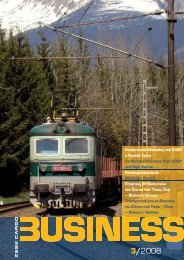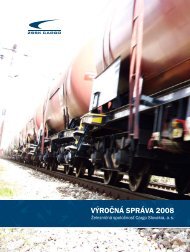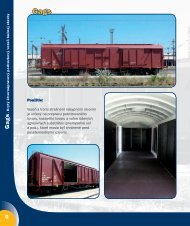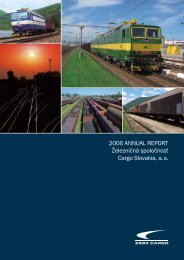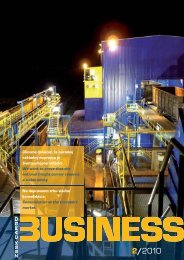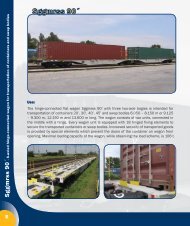CARGO BUSINESS 1-09.indd - ZSSK Cargo
CARGO BUSINESS 1-09.indd - ZSSK Cargo
CARGO BUSINESS 1-09.indd - ZSSK Cargo
- No tags were found...
You also want an ePaper? Increase the reach of your titles
YUMPU automatically turns print PDFs into web optimized ePapers that Google loves.
II. From establishment of ČSD to the end of World War IILast year, we celebrated 160 years from arrival of the first steamtrain to the territory of Slovakia. In a few issues of our magazine, webriefly summarize the most important milestones of this journey.After the formation of independent state of Czechs and Slovaks in1918, the most important task in the area of transport was to maintainoperation on railroad network defined by the new borders. In Slovakia,it particularly meant to fill the positions by new personnel after theHungarian railmen have left and to cope with post-war political shocksof 1919 –strike of remaining Hungarian railmen in February and attackin the south of Slovakia by the Hungarian Soviet Republic army in May.For administration of the Slovak railways, the regional directories ofČSD (Czechoslovak State Railways) in Bratislava and Košice were setup. These were under control of Prague Ministry of Railways.New rail tracksSlovakia inherited the railroad network not suitable for new stateneeds. Efficient north-south railways, connecting Budapest withGalicia, were unused and on the contrary, rail connections in westeastdirection did not meet the new requirements. Moreover, oneefficient railway Košice - Bohumín located here, was just like themajority of Slovak local railways, in private ownership. The statetherefore decided to take over the operation in all private railways,serving for public transport and to complete the Slovak railroadnetwork by new railways.Urgent works on double tracking of the track Devínska Nová Ves -Břeclav and construction of railway Bánovce n. Ondavou – Vojanywere carried out pursuant to Act No. 78/1920. Complex concept ofcompletion of railroad network construction in Slovakia was set byan Act No. 235/1920. On its basis, the rail tracks Zvolen – Krupina,Veselí na Moravě – Nové Mesto nad Váhom. Handlová – Horná Štubňa,Červená Skala – Margecany, Púchov – Horní Lideč, Zlaté Moravce –Zbehy were constructed. The construction of rail track Diviaky - BanskáBystrica was in progress (it was completed during WWII).Revival of economy and transportWith post-war revival of Czechoslovak economy, the long-distancetransport along the new state as well as abroad developed. Thisaspect was especially important for gaining of new marketsfor production of domestic wine makers, green-grocers andstockbreeders in Slovakia.The destination station of fast freight trains, running fromthe beginning of 1920, was particularly Germany, within ČSR(Czechoslovak Republic) north-west Czech spas, Czech north-east,Prague and Tatras. From 1922, foreign transit freight trains fromBalkans to Germany or having the terminus station in ČSR, started torun across the territory of Slovakia.Competition pressures of road freight transport, specializingparticularly in individual packages, stimulated implementation of fastpick-up goods trains with a very short transport period, equipped for aspecific type of goods.An important centre of freight transport in Slovakia was the river portin Bratislava. It provided transportation of foodstuffs, oil products,metals, wood, china and glass. From the second half of the 1920´s,the river port in Komárno, specializing mainly in transhipment of coal,became operative.Great Depression and the beginning of warThe economic crisis in 1920´s and 1930´s affected particularlytransit; domestic transport could have been saved by steadyconsignments of coal. In the second half of the 1930´s, when thecrisis was starting to fade, freight transport increased again, yet toa certain degree, this fact meant the oncoming world war. Its firstserious signals were the Munich Agreement and Vienna Arbitration,shortly followed by disintegration of the republic and formation ofthe independent Slovak state. Slovakia lost almost a third in lengthof its rail tracks and relevant numbers of locomotives and wagons.Operation on remaining tracks was affected the most. The situationcould have been rectified only by support of bus and motor freighttransport and conclusions of peage contracts.International and political relations of ČSR disintegration andformation of this state entity did not provide its representatives withsufficient space for manoeuvres, since the contract on protectiverelationship between Germany and Slovakia significantly weakeneddomestic political as well as international political state sovereignty.Slovak railwaysRailways of a new state were given under administration of thestate-owned enterprise Slovenské železnice (Slovak railways) (SŽ).They were under control of Bratislava Ministry of transport and publicworks. Even though the technical conditions of tracks, “inherited” afterČSD were not bad, their possibilities of operation were limited, mainly




